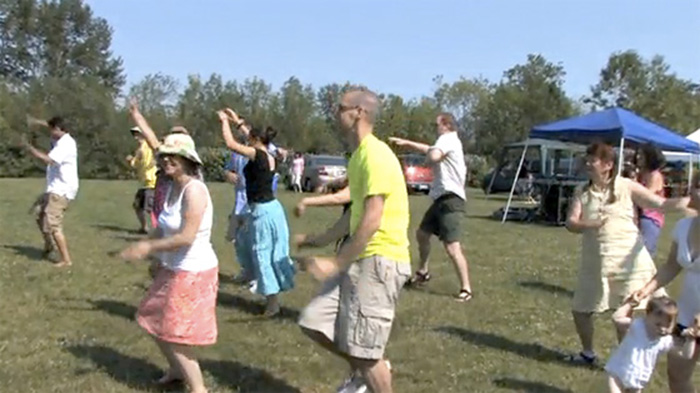
Rating: NR | Runtime: 85 minutes | Release Date: 2011 (USA)
Studio: Green Carpet Studio
Director(s): Zheng Wang

“I went to Africa because someone invited me”
With everything going on in the world and the 2008 recession in full force, five Seattle-based travelers decided to journey to Ghana, Africa, raising funds to support two schools and build a borehole well in a village with desperate need for clean drinking water. Zheng Wang is not only one of the five, but also the director of a documentary called Hope, Ghana, spanning the experience from preparations in the US to the fruits of their labor. Screening at the Buffalo Niagara Film Festival, the film succeeds in displaying a lot of information about the process, the travelers, and the situation across the Atlantic. Questions about whether it would be more practical to just donate the three thousand dollars needed for the trip instead of going there are weighed, apparently failed fundraisers prove to show the generosity of the common man, and the work ethic of Ghana pushes forth to show that, if not for the lack of money, they are willing and able to turn their country around.
Zheng, Laurie Thibert (the group leader who had gone previously with African advocate Jan Kline the year before), Tanya Myers, Roger Gouldberg, and Courtney Hoch are the members of a larger group who came up with the money and time to make good on the promise that they would go. Regular people rising to the occasion, they prove how anyone can help. And just because Ghana is seen as ‘Africa for Beginners’—a modernized English-speaking country in comparison with others around it—doesn’t mean what this quintet does is any less important. Between education problems due to children working 12-hour days to help support their families, the prevalence of Guinea worm in the drinking water, malnutrition, and more, the citizens here are as in need as any others around the world. They welcome American volunteers with open arms, collecting an entire village to greet their guests with food, dance, and, above all, appreciation.
It isn’t just foreigners either that understand the plight and want to help. There are residents such as Lila Macqueen Djaba, a young woman who took it upon herself to create a free school to educate the children in Accra, providing free lunches so the families can survive with them not working for the day; Allotey, a handicapped gentleman who travels by bus three hours each day—both ways—to help teach the kids with Lila; the educators of the Elohim School who have established a place to teach multiple grades; and the members of CRS (Catholic Relief Services) who do everything they can to facilitate change and accommodate groups like Laurie’s without letting the religion of their name interfere. Even the borehole wells paid for by Westerners are done so on a cooperative system, the villagers paying for 5% of the expenses and organizing a team of individuals to be in charge of maintenance and operation. If repairs are needed, the entire community is responsible to cover the costs.

The people of Ghana—or at least the ones Zheng has been allowed to film—aren’t trying to cheat the system or squander the charity given them. They do the work, teach each other English, and fight for everything they can get. An understanding and absolute gratitude comes through in every frame of the film, each African depicted with a smile of hope for the future. As Lila says, she isn’t doing this for herself, but instead for the generations to come. Hopefully the children taught now will remember the kindness showed to them and willingly assist in helping those coming after. It is a cycle that will ideally continue until it’s self-sustaining and effective of true change. And all the while, people like Jan and Laurie will continue to bring more help over, allowing Americans the experience of what Third World nations must contend with, raising awareness, and instilling real change that saves lives.
This is not for everyone and the five Seattle residents do show the stereotypical traits of the kind of people whom you’d think would go on a crusade such as this, but that doesn’t belittle their heart or courage in the process. When expressing their first impression of Africa and what they expect to find, each one comes off as 100% naïve Westerner, but that is part of Hope, Ghana’s charm—a sense that these people really do want to experience the journey and become more educated. Africa isn’t completely covered in wild animal infested jungles, there aren’t pyramids throughout the entire continent, etc—but it is completely endearing to hear Roger admit these early assumptions. He is the most authentic of the bunch, unafraid to speak his mind or even embarrass himself in the process.
Courtney is shown the least, but seems very motivated in her actions; Zheng, when caught in front of the camera rather than behind it, shows the joy in his actions; Laurie often times says exactly the right things, warming the hearts of those she meets and us in the audience watching; and Tanya, the most caricatured of the bunch, oozing child-like glee and bleeding heart, is so filled with passion that she can’t be anything else but sincere. They all work well together and do what they set out to do from day one. It’s a tough process and took much more work than any of them could have guessed, but the reward couldn’t be passed up. Wang shoots it all with a keen eye, not only showing the hardships, but also the happiness flowing through the towns and villages. While the subject itself may not be ‘new’ or ‘fresh’, it is one that remains relevant and if this film helps increase awareness in any way, it will prove itself a success.
photography:
courtesy of Hope, Ghana site

